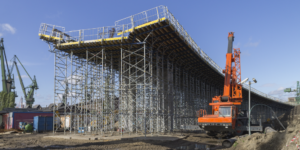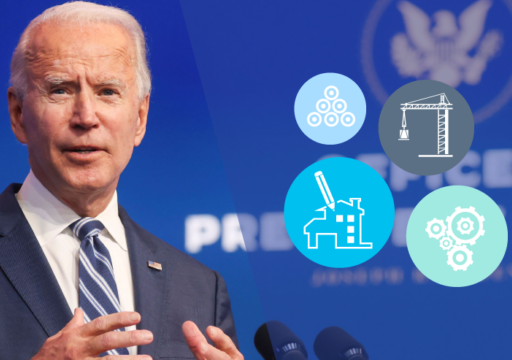
Following President Biden’s March 31, 2021, unveiling of the second part of his administration’s American Jobs Plan, a bipartisan group of senators has agreed to support an ambitious funding package to revive the country’s infrastructure.
Known as the Bipartisan Infrastructure Framework, the $1.2 trillion plan is being touted as a “critical step in implementing President Biden’s Build Back Better vision” that makes “transformational and historic investments in clean transportation infrastructure, clean water infrastructure, universal broadband infrastructure, clean power infrastructure, remediation of legacy pollution, and resilience to the changing climate.”
However, the plan is a significant departure from Biden’s original March 2021 proposal — the administration notes that the proposal only invests two-thirds of the resources that were originally put forth by the Biden administration.
The Eno Center for Transportation’s Jeff Davis found that the plan would spend around $255 billion less than Biden’s original American Jobs Plan proposal.
As the original American Jobs Plan proposed a significant investment in American construction, it’s worth questioning: What’s going to be on the table as part of the Bipartisan Infrastructure Framework?
Where new spending will be focused
The White House noted that the plan will include $579 billion in new spending. Of that total, $312 billion will go to transportation — $109 billion will be invested in roads, bridges, and other major projects, $66 billion will go to passenger and freight rail, and $49 billion will be invested in public transit.
Only $15 billion will be invested in electric vehicle infrastructure and public transportation — a significant step down from the focus that Biden originally sought. However, that keeps the door open for contractors involved in renewable energy industries, as that number is a significant sum that could help continue to drive the renewable energy boom.
Additionally, the plan focuses $266 billion of new spending into soft infrastructure — infrastructure involving healthcare, governmental systems, law enforcement, and education. The Bipartisan Infrastructure Framework specifies $73 billion to be spent on power systems, $65 billion on broadband, and $55 billion for water.
In total, the plan spreads $973 billion — in new spending and baseline spending combined — over five years, and $1.209 trillion over eight years.

11 Ways President Biden Plans To Impact Construction
A number of areas within the construction industry could see benefits, and industry leaders are pushing for them
With such significant amounts of new spending proposed to enter the construction industry within the coming decade, major industry organizations are lauding the possibilities contained in the Bipartisan Infrastructure Framework.
As nothing is official until Congress passes the bill, these areas of the industry are pushing for the bill’s passage, as well. A statement by the Association of Equipment Manufacturers released shortly after the deal’s announcement noted that their organization would continue to advocate for the bill’s passing until it was made official:
“The Association of Equipment Manufacturers and the 2.8 million men and women of this industry have long called for a transformative investment in our nation’s physical infrastructure so they can continue to build, feed, and power the world, and are pleased to see such important progress being announced today…Equipment manufacturers urge lawmakers, staff, stakeholders, and the American public to remain positive and focused on getting this generational bill passed and signed into law.”
Equipment and materials suppliers in particular are set to get a major boost from the infrastructure plan.
United Rentals CEO Matthew Flannery noted that “Most of the infrastructure categories in the administration’s current proposal are directly in our wheelhouse — things like bridges, airports, and clean energy. And we’ll see how the process goes, but almost any infrastructure spending will benefit us in the long term, both directly and indirectly.”
The National Association of Manufacturers — the largest manufacturing association in the United States — released a statement from President and CEO Jay Timmons echoing support for the bipartisan deal: “Bold infrastructure investment will secure a better future for our nation and industry and help more Americans reach their full potential. And building it on a foundation of bipartisanship and consensus will help restore faith in our institutions—and prove that America can still bridge party divides to do great things.”
“We look forward to reviewing this proposal with our members as more details are shared so we can provide meaningful feedback to policymakers,” the statement added.
The National Association of Manufacturers’ statement further details the potential impact of the potential bill, as it claims that the manufacturing industry employs more than 2.3 million people and contributes $2.35 trillion to the US economy.
The American Roads & Transportation Builders Association noted that the deal was a notable step towards getting surface transportation back on track in the country, adding that it advanced “historic investments in America’s highways and public transit systems.” An important surface transportation bill is set to expire on September 30, 2021.
“Time is short as the current transportation funding authorization expires in little more than 100 days,” said American Road and Transportation Builders Association President Dave Bauer. “We urge Congress to move aggressively this summer and pass an outcome-oriented infrastructure bill that boosts U.S. economic productivity and competitiveness.”
Companies that deal in construction aggregates like sand and gravel will also likely see a boost from increased construction spending. “[I]n any definition of infrastructure, if it’s new construction, aggregates is going to be in the foundation,” said Vulcan Materials CEO J. Thomas Hill.
Even before the infrastructure deal was announced, aggregates suppliers were seeing high levels of demand. In early June 2021, Vulcan Materials — one of the country’s largest aggregates producers, with operations in 20 states — was expecting 15% growth over its 2020 operations in the first and second quarters of the year, a number that could signal continued strength for such suppliers after government infrastructure spending actually begins to rise.
Hard infrastructure could see a significant boost
Given the $312 billion investment in transportation, hard infrastructure — commonly thought of as physical infrastructure like roads, bridges, tunnels, railways, ports, and harbors — is likely to receive a significant boost, with a number of opportunities available for contractors, suppliers, and developers.
As a recent NBC News analysis noted, a significant tangible financial return of the plan revolves around the hard infrastructure involved, with a focus on roads and other physical structures that relate to transportation: “Aging roads, bridges, airports, ports and dams will cost America’s economy $3.9 trillion in the decade leading up to 2025, particularly since so much preventative maintenance has been delayed — maintenance that would have saved billions.”
As the report notes, a similar recent investment by Australia may show how large the impact may be for contractors involved with hard infrastructure, noting that “a $3 billion government investment in 2014 provided tax relief and other financial compensation to encourage state governments to sell the right to operate assets to private companies” and resulted in “a $17 billion infrastructure boom, with both the private sector and states kicking in billions of dollars to purchase the assets and rehab them.”
“I think it’s really important, we’ve all agreed that none of us got all that we wanted…That’s what it means to compromise. That’s Democracy. I clearly didn’t get all I wanted but this represents the fact that American Democracy can deliver.”
– President Joseph Biden
Different spending packages could be on the horizon
Though the bill will significantly impact new construction in the country, Biden made it clear that there’s still more funding that he plans to fight for — possibly pointing to more pushes by his administration on infrastructure in the coming years.
“I think it’s really important, we’ve all agreed that none of us got all that we wanted,” the president told reporters following the bipartisan announcement. “That’s what it means to compromise. That’s Democracy. I clearly didn’t get all I wanted but this represents the fact that American Democracy can deliver.”
“The deal announced today, there is plenty of work ahead to bring this home,” Biden noted. “It’s going to require hard work and collaboration. There will be disagreements to be solved and more compromise along the way, but the American people can be proud today.”
Despite bipartisan deal, ideological divisions mean that nothing is set in stone
Though the bipartisan nature of the deal means that the Bipartisan Infrastructure Framework has a good chance of being passed, it’s important to consider that some aspects may shift due to opposition.
Some Senate republicans, such as Pennsylvania Senator Pat Toomey, are already unsure about the plan.
“The Biden administration plan is wildly excessive,” Toomey said in a recent committee hearing. “The administration seems to have lost sight of the fact that the federal role in infrastructure spending has been limited, and state and local governments are primarily responsible [for infrastructure funding].”
Some leaders, such as Toomey are unsure about federal funding for infrastructure, even if they might want to encourage more local spending. “For example, a bus or a light rail station in San Francisco doesn’t really do a lot for people in Pittsburgh,” Toomey said.
“We’ve gotten polarized to the point that Republicans are the rural and ex-urban party and Democrats are the urban and inner suburban party,” said the Eno Center’s Jeff Davis. “And it’s very difficult these days to find a highway versus transit balance that can be acceptable to both parties.”
“If you use the words ‘climate change’ or ‘green,’ Republicans will run away,” Davis added. “…if you can fund most of the exact same projects, the exact amount of money, if you call it resiliency, or extreme weather preparedness or whatever, instead of calling it climate change or green, Republicans will vote for it.”